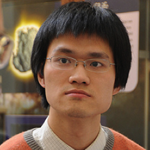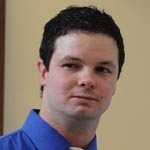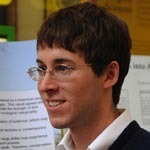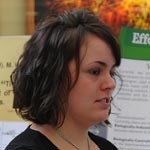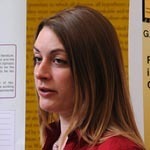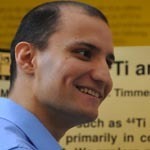College of Science graduate students gave poster presentations at the second annual Graduate Research Symposium on Jan. 22. The judged event, including presenters from Engineering, Humanities and Social Science, was held in the Jordan Hall of Science Galleria. Ian Lightcap received the $500 first place award, and Karsten Steinhaeuser received the $100 second place.
|
|
Shenyu Kuang of the Department of Chemistry and Biochemistry presented “Non-Isotropic Velocity Scaling Reverse Non-Equilibrium Molecular Dynamics.” The research used reduced graphene oxide to anchor semiconductor and metal nanoparticles at separate sites. Photogenerated electrons from titanium oxide were transported to reduce silver ions into silver nanoparticles elsewhere on the graphene. The results could prove useful for the development of catalyst systems and chemical and biological sensors. |
|---|---|
|
|
Ian V. Lightcap of the Department of Chemistry and Biochemistry presented “Anchoring Semiconductor and Metal Nanoparticles on a 2D Catalyst Mat.” The research uses non-isotropic velocity scaling with reverse non-equilibrium molecular dynamics to improve on the older methods. Lightcap applied the approach to the water-gold interface for the first time, an important step for computing interfacial conductivities for non-homogeneous systems. The work, among other things, can help understand the mechanism of freeze desalination. |
|
|
Sean Hoban of the Department of Biological Sciences presented “The Abundant Center Hypothesis, and Range-Wide Patterns of Genetic Structure and Diversity in Butternut.” The research demonstrated that the butternut tree has less genetic diversity in northern regions where it migrated after the last ice sheet retreated. The lack of genetic diversity leaves the population more vulnerable to disease and climate change.
|
|
|
Sarrah Dunham-Cheatham, doing interdisciplinary work in Engineering and Physics, presented on “The Effects of Bacterial Cell Walls on Precipitation of Uranyl Phosphates.” The research revealed that phosphates used to remediate uranium-contaminated groundwater are more effective when bacteria are not present. The phosphates remove more uranium in larger particles that are less likely to re-dissolve. Bacteria removes uranium in smaller particles, and more uranium remained when both phosphates and bacteria were present. |
|
|
Aranda R Slabbekoorn of the Department of Chemistry and Biochemistry, presented “Insights into Alzheimer’s Disease: Tau’s Binding Interactions.” She investigated how the tau protein binds microtubules. She found that Taxol, a tumor-suppressor drug used to keep microtubules intact during studies, changed the binding behavior of tau. The results suggest that the bundles of tau found in the brain of Alzheimer’s patients might have accumulated first on the microtubules. |
|
|
Georgios Magkotsios of the Department of Physics presented on “Trends in Ti44 and Ni56 from Core-Collapse Supernovae.” Although theories about formation of titanium predict that it would be routinely produced in the collapse of supernovae, it is not present in most. The research identified six mechanisms related to synthesis of Ti44. The models show how timescale effects and nuclear reactions may account for the absence of the element. |
| Karsten Steinhaeuser, who works in the Interdisciplinary Center for Network Science and Applications, presented “Descriptive and Predictive Analysis of Climate Data Using Complex Networks.” The study used complex networks to develop a unified framework for analyzing climate data and projecting future climates that allows the descriptive and predictive to inform each other. |
